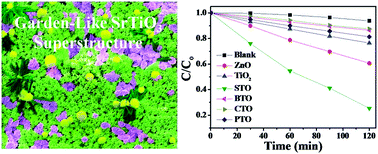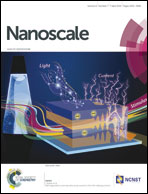Garden-like perovskite superstructures with enhanced photocatalytic activity†
Abstract
By subjecting amorphous flower-like TiO2 to a facile hydrothermal synthesis in the presence of Sr2+, garden-like perovskite SrTiO3 superstructures were achieved. The amorphous TiO2 was preformed using ZnO flowers as templates. Different three-dimensional SrTiO3 architectures were coexisted in the garden, including SrTiO3 flowers composed of several hollow sword-shaped petals, many sheet-shaped petals or numerous flake-shaped petals, and SrTiO3 grass consisting of a number of long blades. These SrTiO3 superstructures were simultaneously grown on fluorine-doped tin oxide (FTO) substrates. On the basis of a comprehensive study on the effects of growth time, temperature, initial concentrations of precursor, and pH, the formation of these various hierarchical architectures was attributed primarily to the dissolution of amorphous TiO2 and precipitation of perovskite crystals, followed by the Ostwald ripening process of perovskite nanocrystals and self-organization of perovskite building blocks. Interestingly, this approach can be readily extended to create other perovskite structures, including dendritic BaTiO3 and nest-like CaTiO3, as well as PbTiO3 transformed from plate-like pyrochlore Pb2Ti2O6 after post-thermal treatment. Garden-like SrTiO3 superstructures showed a superior photocatalytic performance when compared to other as-prepared semiconductors and perovskite materials (i.e., ZnO, TiO2, BaTiO3, CaTiO3 and PbTiO3), probably due to their intrinsic photocatalytic activity and special garden-like features with a coexistence of various structures that significantly facilitated the adsorption and diffusion of methyl blue (MB) molecules and oxygen species in the photochemical reaction of MB degradation.


 Please wait while we load your content...
Please wait while we load your content...